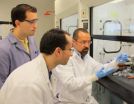(Press-News.org) CHICAGO --- When a traffic light at a busy intersection flashes the WALK sign, people with knee osteoarthritis worry they can't walk fast enough to make it across the street in time. New Northwestern Medicine research shows people with this common arthritis are more likely to walk fast enough if they lead physically active lives.
"The more active people are, the faster they can walk," said Dorothy Dunlop, associate professor of medicine at Northwestern University Feinberg School of Medicine and lead author of the study. "This is strong evidence that even a small increase in activity is related to better walking function. The bar for improvement isn't that high. This should motivate people to get moving, even if they have pain or stiffness."
The study is published in the January issue of Arthritis & Rheumatism.
Knee osteoarthritis is a leading cause of disability in adults. As it progresses, it can threaten an individual's ability to live independently. Maintaining function and independent living is an important goal for the more than 27 million U.S. adults with osteoarthritis.
"This study provides encouragement for people who are on the low end of the physical activity spectrum to increase their physical activity," said Dunlop, a health services researcher who also is with the Institute for Healthcare Studies at Feinberg. "You don't have to be in the top physical activity group before you start to see improvements in your walking speed."
Physical activity produces big benefits for people with knee osteoarthritis. In addition to improving the ability to walk, physical activity also promotes healthy joint cartilage and reduces pain, depression and fatigue, Dunlop noted.
Federal guidelines recommend adults with arthritis should participate in at least 2.5 hours a week of moderate intensity, low-impact activity in sessions lasting 10 minutes or more. Even if people can't meet these levels, Dunlop said they should be as physically active as possible.
The Osteoarthritis Initiative, an observational study, surveyed 2,500 participants with knee osteoarthritis. Participants filled out self-reported questionnaires about their physical activity at sites in Columbus, Ohio, Baltimore, Md., Providence, R.I., and Pittsburgh, Pa.
Researchers divided participants into four physical activity groups, from lowest to highest, using a general activity score. In the lowest physical activity group, less than half, or 49 percent, walked fast enough to cross the street before the light changed. (Traffic lights generally allow a walking speed of four feet per second.) In the next three higher physical activity groups, 63 percent, 71 percent and 81 percent, respectively, walked fast enough to cross the street.
INFORMATION:
The study was sponsored by the National Institute of Arthritis and Musculoskeletal and Skin Diseases.
END
UNC scientists who study how cells repair damage from environmental factors like sunlight and cigarette smoke have discovered how a "chaperone" enzyme plays a key role in cells' ability to tolerate the DNA damage that leads to cancer and other diseases.
The enzyme, known as Rad18, detects a protein called DNA polymerase eta (Pol eta) and accompanies it to the sites of sunlight-induced DNA damage, enabling accurate repair. When Pol eta is not present, alternative error-prone polymerases take its place – a process that leads to DNA mutations often found in cancer cells. ...
CAMBRIDGE, Mass., Jan. 18, 2011 -- Physicists and bioengineers have developed an optical instrument allowing them to control the behavior of a worm just by shining a tightly focused beam of light at individual neurons inside the organism.
The pioneering optogenetic research, by a team at Harvard University, the University of Pennsylvania, and the University of Massachusetts Medical School, is described this week in the journal Nature Methods. Their device is known as the CoLBeRT (Controlling Locomotion and Behavior in Real Time) system for optical control of freely moving ...
A study led by Dr. Tom P. Aufderheide, professor of emergency medicine at The Medical College of Wisconsin, shows an alternative method of cardio-pulmonary resuscitation increases long-term survival of patients.
The study, which is published in the January 19th, 2011 online version of Lancet, and will be in an upcoming publication of Lancet, determined that active compression-decompression cardio-pulmonary resuscitation (CPR) with augmentation of negative intrathoracic pressure gave patients a better chance of survival. When the pressure inside the thorax decreases, ...
CHICAGO – January 18, 2011 – Maintaining periodontal health may contribute to a healthy respiratory system, according to research published in the Journal of Periodontology. A new study suggests that periodontal disease may increase the risk for respiratory infections, such as chronic obstructive pulmonary disease (COPD) and pneumonia. These infections, which are caused when bacteria from the upper throat are inhaled into the lower respiratory tract, can be severely debilitating and are one of the leading causes of death in the U.S.
The study included 200 participants ...
A complex sugar may someday become one of the most effective weapons to stop the spread of cholera, a disease that has claimed thousands of lives in Haiti since the devastating earthquake last year.
A technique developed by University of Central Florida scientists would allow relief workers to test water sources that could be contaminated with the cholera toxin. In the test, the sugar dextran is coated onto iron oxide nanoparticles and then added to a sample of the water. If the cholera toxin is present, the toxin will bind to the nanoparticles' dextran. This is because ...
EVANSTON, Ill. --- Researchers at Northwestern University have placed nanocrystals of rock salt into lead telluride, creating a material that can harness electricity from heat-generating items such as vehicle exhaust systems, industrial processes and equipment and sun light more efficiently than scientists have seen in the past.
The material exhibits a high thermoelectric figure of merit that is expected to enable 14 percent of heat waste to electricity, a scientific first. Chemists, physicists and material scientists at Northwestern collaborated to develop the material. ...
LA JOLLA, CA – January 18, 2011 – Using chemical compounds found in a Japanese plant as a lead and the clever application of ultraviolet light, a Scripps Research Institute team has created a unique library of dozens of synthetic compounds to test for biomedical potential. Already, one of the compounds has shown great promise in inhibiting replication of HIV particles and fighting inflammation.
With the report of their work scheduled to appear in the online Early Edition of Proceedings of the National Academy of Sciences this week, the researchers now plan to optimize ...
CHAMPAIGN, Ill. — Researchers have determined the structure and mechanism of an enzyme that performs the crucial first step in the formation of cholesterol and a key virulence factor in staph bacteria.
Chemists at the University of Illinois and collaborators in Taiwan studied a type of enzyme found in humans, plants, fungi, parasites, and many bacteria that begins the synthesis of triterpenes – one of the most abundant and most ancient classes of molecules. Triterpenes are precursors to steroids such as cholesterol.
"These enzymes are important drug targets," said chemistry ...
While every cell of an organism contains the same genes only a proportion are expressed in any tissue at a given stage in development. Knowing the extent of gene transcription is valuable and a team of European researchers has generated an atlas of gene expression for the developing mouse embryo. This will be a powerful resource to determine co-expression of genes and to identify functional associations between genes relevant to development and disease. The findings will be published next week in the online, open access journal PLoS Biology.
The comprehensive, interactive ...
Severe asthma in early childhood may lead to premature loss of lung function during adolescence and more serious disease during adulthood, researchers at Emory University School of Medicine report. Early identification and treatment of children with severe asthma is important to help stem asthma progression.
In an article available online in the January issue of the Journal of Allergy and Clinical Immunology at http://www.jacionline.org/article/S0091-6749%2810%2901651-9/fulltext, Anne M. Fitzpatrick, PhD, and W. Gerald Teague, MD, and colleagues report on their study of ...


